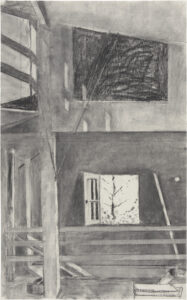New Yorker: Richard Diebenkorn

April 6, 2022
This trove of drawings and paintings on paper, made between 1946 and 1992, is one of many exhibitions planned this year to celebrate the centennial of this inimitable Bay Area painter, who died in 1993. Whether a Diebenkorn piece is abstract or figurative, black-and-white or in color, geometric or gestural, it is always an etheric-architectural articulation of space, a fact that is underscored here by the installation of an untitled charcoal drawing, dated 1988-92, between a pair of arched windows. The piece depicts clean lines and a play of light in Diebenkorn’s studio in the Sonoma Valley, but his touch renders the interior as if it might dissolve into a landscape glimpsed through an open window at the center of the composition. On the exhibition’s second level, a vitrine is lined with ephemera, including a handwritten ten-point list titled “Notes to myself on beginning a painting.” Among its sage aphorisms is the command to “tolerate chaos,” which might help to explain the exciting flux and the unfussy moments of order uniting his lifetime of work.
— Johanna Fateman